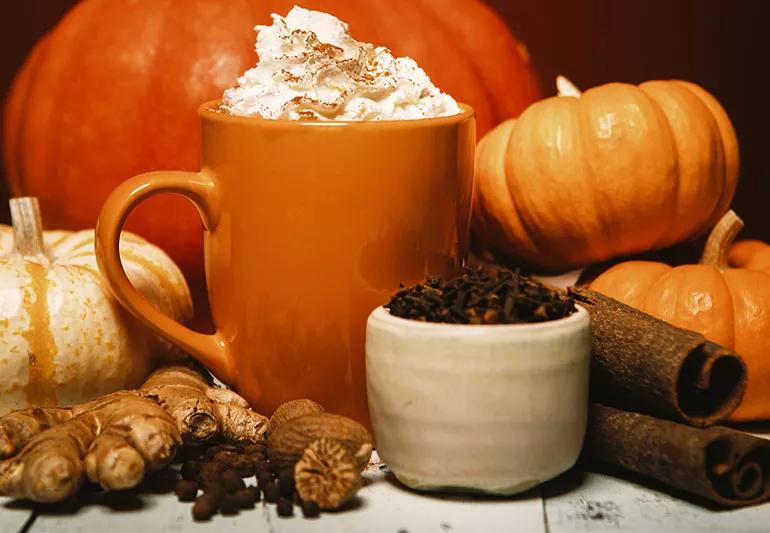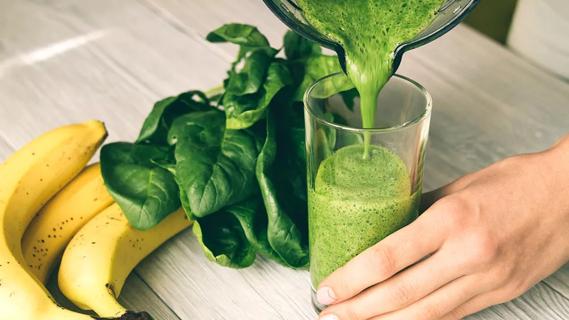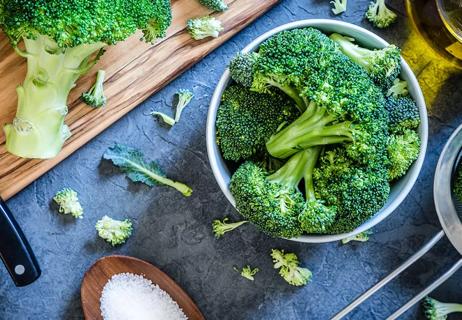It’s the flavor of fall, but it’s good to be wise about how you consume it

You know fall is fast approaching when you start seeing PSL (pumpkin spice lattes) and other pumpkin spice-flavored or scented items, from muffins and protein powder to yogurt and trash bags (we’re not kidding).
Advertisement
Cleveland Clinic is a non-profit academic medical center. Advertising on our site helps support our mission. We do not endorse non-Cleveland Clinic products or services. Policy
And while autumn is a time for apple-picking, leaf-peeping and scarecrows, you may be wondering if all that pumpkin spice you’re consuming is doing your body any good.
The answer isn’t so straightforward, says registered dietitian Julia Zumpano, RD, LD.
Zumpano breaks down how the spices in pumpkin spice — cinnamon, ginger, nutmeg and cloves — offer some health benefits. But she also addresses why you need to pick and choose your pumpkin spice products carefully to avoid excessive amounts of added sugar and calories.
It can be. We’re not saying it’s OK to chug a pumpkin spice latte every day or make a pumpkin spice doughnut a part of your morning breakfast routine, though.
Many of the food and drink items that contain pumpkin spice also tend to have added sugar and are high in calories (we’re looking at you, pumpkin pie jelly beans and pumpkin spice sandwich cookies). For example, a large pumpkin spice latte comes in around 400 calories and has more than 60 grams of sugar. Yikes!
But when you smartly use the pumpkin spice mixture that you find in your spice drawer (for example, sprinkled on top of your coffee or overnight oats), you may reap certain benefits like a reduction in inflammation and cholesterol.
Advertisement
And what about pumpkin and all the perks it has? Spoiler alert: While pumkin is great for your eyes, heart and immune system, pumpkin spice doesn’t contain any real pumpkin. Pumpkin spice is frequently used in pumpkin recipes to evoke that cozy, autumnal feeling.
Thanks to its unique (and tasty) mix of spices, if used correctly, pumpkin spice comes with some nice health benefits. Here’s how each individual spice found in pumpkin spice shakes out.
The popular spice — which is made from the bark of a cinnamon tree — contains vitamins and minerals like iron, zinc, calcium, chromium, manganese and magnesium.
Cinnamon also boasts anti-inflammatory properties (thanks to the antioxidant compound called cinnamaldehyde), and may help reduce blood sugar levels and even help reduce cholesterol.
“Research on cinnamon shows that it may reduce inflammation due to its high levels of salicylic acid and also can help with reducing levels of bad cholesterol and increasing good cholesterol,” says Zumpano.
When it comes to ginger, the spice can aid in joint pain, improve blood sugar regulation and may help lower cholesterol.
Ginger — which has been used in Eastern medicine since the 9th century — may be known mostly for its ability to help with your gut health.
“Ginger can help with nausea, vomiting and constipation. It helps settle an upset stomach,” adds Zumpano. “It also has anti-inflammatory and antioxidant compounds that protect you from oxidative stress and damage.”
You may turn to nutmeg to add a little nutty flavor to your recipes, but your health may also benefit from it (there are claims that it may boost your libido).
But it may take us some time to fully understand how nutmeg benefits us — many of the studies were conducted on animals, explains Zumpano, who says that more research is needed.
What we do know? Research shows that like many of the other spices in pumpkin spice, nutmeg contains antioxidant and anti-inflammatory compounds.
“Nutmeg adds a great nutty flavor to pumpkin spice, which makes it appealing for sweet and savory dishes,” notes Zumpano.
Have a toothache? You may have heard that clove oil can help soothe toothaches and prevent gum disease. In fact, the popular herb has been used in traditional Chinese medicine and Ayurvedic medicine.
But it’s important to note that while some scientific studies have been done, the results have been mixed. And there’s a caveat — most of the studies use clove oil versus ground clove (which is found in pumpkin spice).
Advertisement
“Cloves can have a strong flavor, but in pumpkin spice, its punch is neutralized well by the other spices,” explains Zumpano. “For a more subtle taste, use cloves whole.”
There are endless pumpkin spice-flavored foods and drinks available. But that doesn’t make them all good for you. Zumpano says you need to pay attention to how much added sugar something contains. Your best bet? Get your pumpkin spice fill by adding pumpkin spice at home.
“Have a shaker of pumpkin spice at home to use in your coffee, tea or oatmeal,” she suggests. “You can use it in a muffin mix, soup or a homemade latte or smoothie. That way you can control how much pumpkin spice you’re using.”
While you can buy a pre-blended jar of pumpkin spice at your local grocery store or online, Zumpano says it’s pretty easy to make your own version at home. Be sure to read the ingredients and avoid any added sugars.
Most importantly, if you want the benefits of pumpkin spice, you need to use it regularly.
“It’s all about the consistency of it — using it every day versus using it occasionally,” she says. “That’s why it’s a good idea to keep pumpkin spice (or even cinnamon) next to your coffee maker or tea kettle so you easily can use it in the morning.”
Advertisement
It’s OK to be a pumpkin spice fan. And there’s no harm in jumping on the pumpkin spice bandwagon. You just need to be smart about the items and products you consume. That pumpkin spice croissant should be a one-time treat instead of a daily indulgence.
“Remember, just because a lot of products claim it’s a pumpkin spice latte, muffin or scone, that doesn’t necessarily mean it comes with all the health benefits that real pumpkin spice that comes in spice jar can provide,” cautions Zumpano.
Advertisement
Learn more about our editorial process.
Advertisement

Lettuce is a versatile vegetable loaded with antioxidants and good-for-you nutrients

This unique-looking veggie is fiber-dense and antioxidant-rich, and can improve the health of your gut, liver and heart

Vitamin-packed and antioxidant-rich, spinach can benefit your brain, eyes, blood and more

These ‘tiny trees’ provide disease-fighting nutrients and may protect your gut

This classic veggie can boost your heart health, help with digestion, fight off hunger and more

Rich in fiber and folate, this veggie helps calm your gut and lower your blood pressure

Maximize the power of the nutritious purple produce with these flavorful dishes

Type 2 diabetes isn’t inevitable with these dietary changes

Applying a hot or cold compress can help with pain